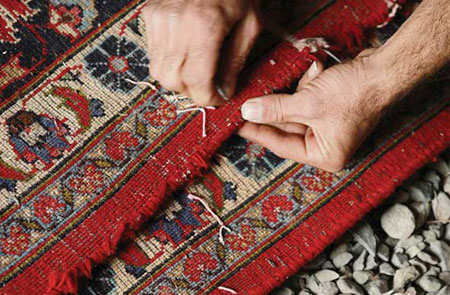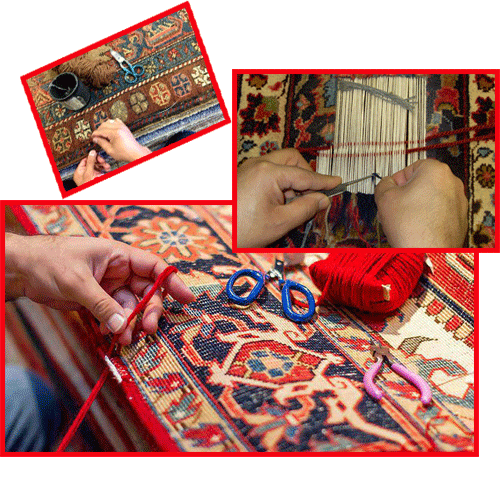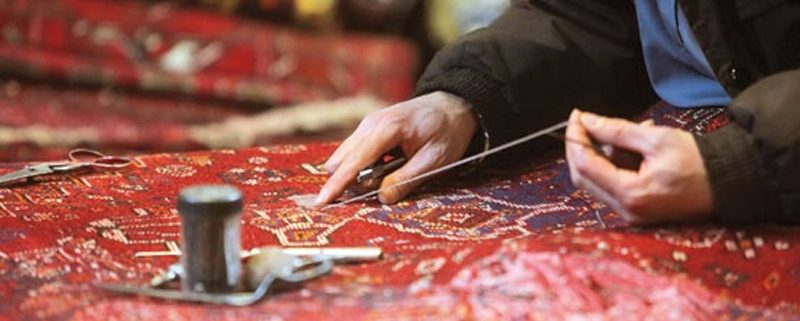Restoration and refurbishment of mosque carpets and machine-made carpets
Refurbishment and restoration mosque carpets and prayer rugs, are needed after several years of use. Usually, mosque carpets need to be repaired, rooted or even replaced after 5 or 7 times of washing or after 6 to 7 years. If the carpet is good, nothing will happen to the carpet texture during repeated washing. This shows the quality of yarn used in altar carpets. The better the raw material, the longer the rug lasts. repairing mosque carpets and machine-made carpets are often done with machine. Repairing, reconstructing and refurbishing a rug means completing or eliminating the defects of the rug and is an action that usually requires special experience and skills. As a result, people who do this must have a long history in weaving, dyeing, recognizing the color and raw materials of the carpet.

There are three categories of carpet damage – need to refurbishment
A. Minimal damage with easy repair: Includes repair of Shirazeh dislocation – Repair of rupture (loss of roots) – Removal of surface stains. This type of damage is not necessarily related to the text and design of the carpet, and sometimes ready-made roots are used to emboss the carpet. In cases where the roots have been lost one by one or at different distances, the carpet can be completed by inserting similar yarn at the edge of the carpet. To repair, it is better to completely empty the damaged areas next to the carpet and then complete with the same color thread and the same thickness. In the case of small and superficial stains, a good result can be obtained by a small amount of scisso. Of course, if it does not make much difference in the height of the lint. In terms of removing stains, the use of Paint-removing material is not recommended because it fades all the paint under the stain.
B. medium damage with medium repair – Includes abrasions, small Ruptures, and bruises. In this injury, the carpet edges are usually healthy and usable. C. Excessive damage with difficult repair, Includes the following and similar: Burns, decay, sharp objects, heavy blows or high humidity. In this type of damage, the knots are usually destroyed along with the carpet and need to be repaired.
Necessary measures before refurbishment the carpet
First, the carpet dust must be completely removed. Spread the rug on a flat surface to inspect the holes. If the hole is caused by chemicals such as acidic or alkaline, wash the carpet first. If the altar carpet has several holes and the distance between these holes is Low (ie, the ratio of the surface of the holes to the surface of the remaining tissue is higher), the threads and healthy parts between the holes should be cut and a large hole made.

Some important points about refurbishment mosque carpets and machine-made carpets
1- For carpets that are rotten and their sheen does not have the necessary resistance, especially in the case of old and valuable carpets, the threads should not be torn as much as possible. Rather, in special ways that the embossers themselves are familiar with, they thread and tighten the threads from the inside.
2- Carpets that have been damaged from the front (or their lint has been removed) are repaired from the up of carpet; And carpets that are damaged from the back will be repaired from the back of the carpet.
The type of injury must be determined. In the case of torn or perforated carpets, the damaged surface is tightened. Lint or fibers that are not strong enough should be cut. The map of the torn or damaged part should be determined from the healthy parts of the carpet and, if possible, redesigned and prepared. Refurbishing equipment should be prepared and available

Rug refurbishment tools
carpet refurbishment tools include scissors, hooks, special needles, coarse needles, a narrow mouthpiece (or pliers) and the required yarns.
Older and more experienced professionals usually add tools such as hammers, nails, bowls, bottles, irons, keels (a type of needle of card machines in textile mills) and wax to this collection as needed.
